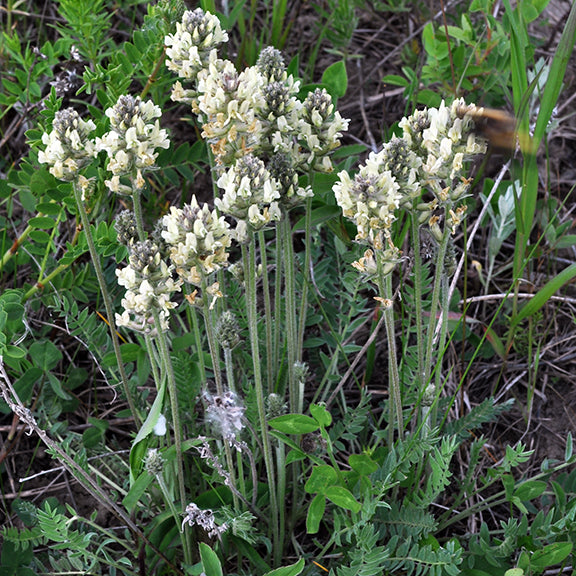Wild About Flowers
Oxytropis monticola - Mountain Locoweed
Oxytropis monticola - Mountain Locoweed
Couldn't load pickup availability
Mountain Locoweed features silvery-green, fern-like foliage that adds soft texture, while clusters of white pea-like flowers, tinged with lavender to purple, bloom from early to mid-summer, attracting native bees, particularly bumblebees, and butterflies. Like all locoweeds, it is toxic to livestock, and although its heavy seed doesn't travel far, care should be taken when planting in rural areas where grazing animals are present. For a longer bloom period and a striking display, pair it with other Locoweed species.
A hardy, drought-tolerant, long-lived perennial, Mountain Locoweed is well-suited for xeriscapes and self-sustaining landscapes. Deep-rooted and highly resilient, it thrives in urban pollinator gardens and naturalized plantings, adding both beauty and ecological value to sunny, hot environments.
Bloom Times & Plant Sizes
Bloom Times & Plant Sizes
Important Information - The "Bloom Period" is an indicator of the time period within which the wildflowers will bloom and does not describe the time period that a single plant will bloom. The "Sizes" listed are intended to be a general guideline to consult during plant selection. - Plant growth and bloom times will vary depending on geographical location & individual site conditions.
Edible & Medicinal Info Disclaimer
Edible & Medicinal Info Disclaimer
The Edible & Medicinal information on this site is for informational purposes only and should not be acted on without thorough research and professional guidance. We are not responsible for any adverse effects resulting from the use of or misidentification of plants.
Share




Plant Specifics
Seeds Per Pack
Seeds Per Package: 20
Light Conditions
- Sun
Soil Conditions
- Dry
- Sandy
- Gravelly
- Well Drained
Height
- Under 12"
- 12" - 24"
Width
- Under 12"
Bloom Colour
- White
Month of Bloom
- May
- June
- July
Vigorousness
- Moderate
Deer Resistance
- High
Features
- Butterflies
- Bees
- Long Bloom Time
- Urban Spaces
- Rural Spaces
- Toxic or Posionous Parts
Chinook Exposure
- Fully Exposed
Distribution Info
Native to western North America, including AB and BC, and extending into the Rocky Mountains and foothills of the northwestern U.S. It is commonly found in alpine and sub-alpine meadows, open slopes, and rocky ridges at higher elevations.
Traditional Edible & Medicinal Info
⚠️ Oxytropis species contain toxic alkaloids, which affects the nervous system of livestock and wildlife.




